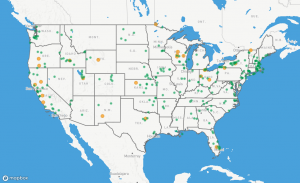
“Farmers have got to up their game”
New research just out from the Environmental Working Group (EWG) shows a growing number of algal blooms since 2010 – at least 300 blooms in lakes, rivers and bays in 48 states.
The new report also shows 169 toxic blooms were reported in 40 states in 2017, compared to only three blooms in 2010.
But EWG says no government entity tracks the blooms nationwide. The group also says the government isn’t doing enough to stop the blooms from spreading further.
Great Lakes Now talked with author of the report, Craig Cox, Senior V.P. for agricultural and natural resources at the Environmental Working Group. He leads the organization’s research and advocacy around U.S. farming practices and their implications for public health.
Cox says Lake Erie’s algal blooms in 2014 which endangered drinking water for Toledo residents sounded an alarm across the nation. He says, “We started to look more closely at the implications for people. And it’s really scary.” Cox says many people don’t realize that harmful algal blooms can cause everything from headaches to liver damage to cancer. And he says it’s no secret that Lake Erie’s algae problems are caused by fertilizer from agricultural run-off.
Testing for toxic algae is voluntary
Cox says many people also don’t realize that testing for toxic algae is voluntary for municipal water utilities.
Cox says, “Under the safe drinking water act, if a contaminant in drinking water is not officially regulated – in other words, if they don’t have a legal limit set for how much of that contaminant can be in drinking water – then utilities don’t have to test for that contaminant. And as of today, there is no legal limit on the toxins that these algaes produce. So it’s really voluntary whether utilities are testing for these cyanotoxins or not. “
“Farmers have got to up their game”
How to fix the problem? Cox tells Great Lakes Now it’s time for the government to step in to do better tracking of algal blooms across the U.S. – and not leave it up to organizations like his to tally up how bad the problem is getting. But most important, says Cox: “Farmers have got to up their game.” Cox suggests, “In return for the billions in crop insurance subsidies farmers enjoy, it’s fair to expect them to do just a little bit more to protect taxpayers and citizens from these algal blooms by taking some simple measures on their farms that would prevent run-off.”
The House failed to pass the Farm Bill Cox mentioned last week.
The senate is expected to hold a mark-up session on its version of the farm bill in the coming weeks.
The Farm Bill contained the largest investment in conservation programs in the federal budget—programs that pay farmers to take specific actions to improve the health of soil, water, and the environment.
Cox says, “What really needs to happen: we need to spend much more time and resources on preventing these algal blooms in the first place instead of relying on utilities to treat the problem once the problem is there.”
Featured Image: Harmful Algal Bloom in Western Basin of Lake Erie, Image by Aerial Associates Photography, Inc. (Zachary Haslick) via NOAA cc 2.0
1 Comment
-
I wonder how many people know that their own nitrogenous waste (urine and protein) is not treated under the CWA. This, while this waste not only robs oxygen, but is a fertilizer for algae. The reason it is not required to be treated is caused by a faulty test EPA used to establish sewage treatment standards. So much easier to blame others!





